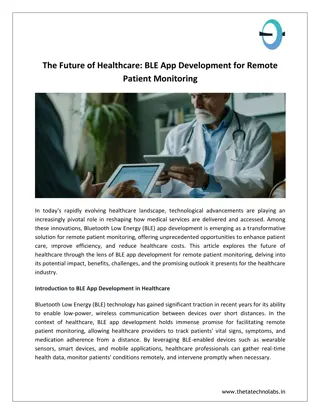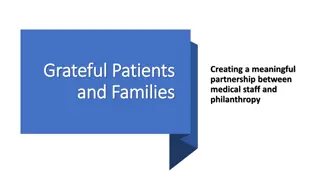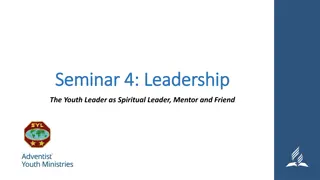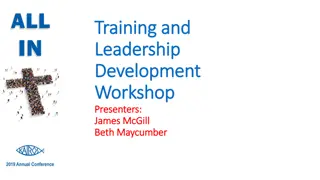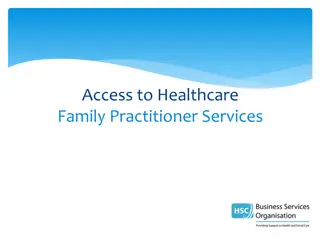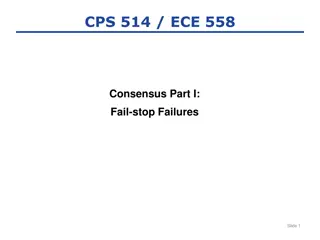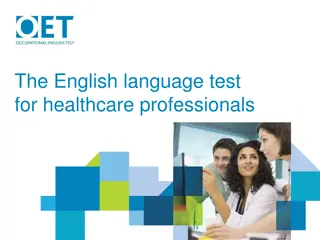Understanding the Leader Role in Healthcare
Physician leaders play a crucial role in healthcare by fostering collaborative leadership, managing resources efficiently, and prioritizing stewardship. The Leader Role encompasses engaging with others to contribute to a high-quality healthcare system and ensuring excellent patient care delivery. It involves dynamic leadership practices, including supporting others to lead and managing personal and professional practice competencies.
Download Presentation

Please find below an Image/Link to download the presentation.
The content on the website is provided AS IS for your information and personal use only. It may not be sold, licensed, or shared on other websites without obtaining consent from the author. Download presentation by click this link. If you encounter any issues during the download, it is possible that the publisher has removed the file from their server.
E N D
Presentation Transcript
T2 - Teaching the Leader Role Author: Lorem ipsum dolor sit Date: Dolor sit am
The unmodified content below was created for the CanMEDS Teaching and Assessment Tools Guide by S Glover Takahashi and is owned by the Royal College of Physicians and Surgeons of Canada. You may use, reproduce and modify the content for your own non- commercial purposes provided that your modifications are clearly indicated and you provide attribution to the Royal College. The Royal College may revoke this permission at any time by providing written notice. NOTICE: The content below may have been modified from its original form and may not represent the opinion or views of the Royal College. 2
Objectives and agenda 1. Recognize the process and content of leadership 2. Apply key leadership skills to examples from everyday practice 3. Develop a personal leadership resource for everyday practice 3
Why the Leader Role matters Physician leaders play an important part in health care Collaborative leadership competencies help facilitate improvements The health care system depends on physicians taking responsibility for stewardship of finite resources Physicians must make personal management skills a priority to manage competing demands 4
The details: What is the Leader Role As Leaders, physicians engage with others to contribute to a vision of a high-quality health care system and take responsibility for the delivery of excellent patient care through their activities as clinicians, administrators, scholars, or teachers. 5
About the Leader Role The Leader Role facilitates the expression of leadership no matter what title a physician may or may not hold. Dynamic leaders know when and how to stand back, support and enable others to lead Leader Role continues to include important manager competencies (i.e. management of personal and professional practice) 6
Key terms for Leader Stewardship Quality improvement Patient safety 7
Recognizing Leader process Organizing Culture Prioritizing Changing Scheduling Transitioning Budgeting Continuously improving Running a team, unit, department, service Following Managing Stewarding, Choosing wisely Implementing Delegating Utilizing technology Strategizing, Monitoring 8
Recognizing Leader content Patient flow Culture Resources (e.g. human, financial, equipment) Patient safety Incident Time management Quality improvement Workflow Systems thinking Schedule Priorities Human resources Strategy Career planning Effectiveness Integrity Efficiency 9
Leadership improves with feedback 1. Ask someone who is willing and can be constructive 2. Ask for SPECIFIC feedback 3. Listen and focus on what is helpful and specific (i.e. Don t interrupt. Watch for resistance and defensiveness) 4. Say thank you for the input 10
Analyse quality in day-to-day practice Six domains of health care quality 1. Safe 2. Effective 3. Patient-centered 4. Timely 5. Efficient 6. Equitable 11
Quality improvement framework 1. What are we trying to accomplish? 2. How will we know that a change is an improvement? 3. What changes can we make that will result in improvement? 12
PDSA Plan-Do-Study-Act Used to test and implement changes in practice 13
Stewardship of resources Be aware of stewardship issues, options, decisions based on individual patient needs, preferences, and values of the patient and organization. Use guidelines to inform appropriate use of testing and get info from Choosing Wisely Canada Consider How will the result of this test influence our overall management plan? If no bearing on the overall treatment plan, then it is likely of minimal benefit and should not be ordered 14
Patient Safety Models a safety culture including demonstrating a commitment to openness, honesty, fairness and accountability Expect the unexpected. Anticipation and prevention of errors is important as is vigilance and readiness 15
Patient Safety Incident Patient safety incident is an event or circumstance that could have resulted, or did result, in unnecessary harm to a patient. Harm is due to the medical care provided, not the underlying medical illness. Three types of patient safety incidents are: 1. A harmful incident results in harm to the patient, 2. A no harm incident reaches a patient but does not result in any discernible harm, 3. A near miss does not reach the patient 16
Key actions when patient safety incidents occur Meet the immediate and ongoing care needs of the patient (ensure the patient is clinically stable, correct the safety issue(s), limit further harm, and provide ongoing monitoring and care). Explain to the patient what unexpected event or change happened including who, how, what and prevention Apologize that it happened Explain what will happen next, including actions to avoid recurrance 17
Manage career planning, finances, and health human resources Set priorities and manage time to integrate practice and personal life Be mindful and deliberate about managing busy schedules Use tools to get/stay organized 18
Share the work through effective delegation Organize Identify the priority tasks Establish the steps and sequence key Inventory available resources Assign people the authority and responsibility for important activities. Assign based on match/fit and/or need for skill development Monitor, communicate, clarify and coach Deploy or redeploy people to new assignments 19
Objectives and agenda 1. Recognize the process and content of leadership 2. Apply key leadership skills to examples from everyday practice 3. Develop a personal leadership resource for everyday practice 20
References Dath D, Chan M-K, Anderson G, Burke A, Razack S, Lieff S, Moineau G, Chiu A, Ellison P. Leader. In: Frank JR, Snell L, Sherbino J, editors. CanMEDS 2015 Physician Competency Framework. Ottawa: Royal College of Physicians and Surgeons of Canada; 2015. http://www.choosingwiselycanada.org Stone D, Heen S. Thanks for the Feedback: the science and art of receiving feedback well. New York: Viking; 2014. Six Domains of Health Care Quality. Consumer Assessment of Healthcare Providers and Systems (CAHPS) website. Last retrieved July 3, 2015 from: https://cahps.ahrq.gov/consumer- reporting/talkingquality/create/sixdomains.html. Langley GL, Nolan KM, Nolan TW, Norman CL, Provost LP. The Improvement Guide: A Practical Approach to Enhancing Organizational Performance 2nd Ed. Jossey Bass, San Francisco 2009. See more at (last retrieved July 3, 2015): http://www.institute.nhs.uk/quality and service improvement_tools/quality_and_service_improvement_tools/plan_do_st udy_act.html. 21
Other Slides 22
Leader Key Competencies Physicians are able to: 1. Contribute to the improvement of health care delivery in teams, organizations, and systems 2. Engage in the stewardship of health care resources 3. Demonstrate leadership in professional practice 4. Manage career planning, finances, and health human resources in a practice 23
Leader Key Competency 1 Physicians are able to: 1. Contribute to the improvement of health care delivery in teams, organizations, and systems 1.1 Apply the science of quality improvement to contribute to improving systems of patient care 1.2 Contribute to a culture that promotes patient safety 1.3 Analyze patient safety incidents to enhance systems of care 1.4 Use health informatics to improve the quality of patient care and optimize patient safety 24
Leader Key Competency 2 Physicians are able to: 2. Engage in the stewardship of health care resources 2.1 Allocate health care resources for optimal patient care 2.2 Apply evidence and management processes to achieve cost appropriate care 25
Leader Key Competency 3 Physicians are able to: 3. Demonstrate leadership in professional practice 3.1 Demonstrate leadership skills to enhance health care 3.2 Facilitate change in health care to enhance services and outcomes 26
Leader Key Competency 4 Physicians are able to: 4. Manage career planning, finances, and health human resources in a practice 4.1 Set priorities and manage time to integrate practice and personal life 4.2 Manage a career and a practice 4.3 Implement processes to ensure personal practice improvement 27
Effective leaders: Have courage and take responsibility for errors Three Rules of apologies: 1. Be honest and authentic 2. Do not explain 3. Do not use the word but Steps to an effective apology: 1. Express remorse: I am sorry. 2. Take responsibility for actions or behaviour. 3. Make amends for your actions to make the situation right where appropriate and within your authority. 4. Rebuild trust. Repair the relationship. 28






